This vegetable is good for everyone: unpretentious, gives a large harvest, is well stored and very healthy. We are talking about a pumpkin, planting and caring in the open ground for it is possible even for a novice gardener.
Material Content:
Varieties of pumpkins for open ground
There are many of them. Pumpkins differ in maturity and size of the fruit. There are other differences: the sugar content, and, therefore, the sweetness of the fruit, the ability to withstand long-term storage, cold resistance. The choice of variety depends on the region of cultivation. Heat-loving varieties will not ripen in places with a cold climate. Our experts will recommend pumpkins that will give a guaranteed harvest in any region.
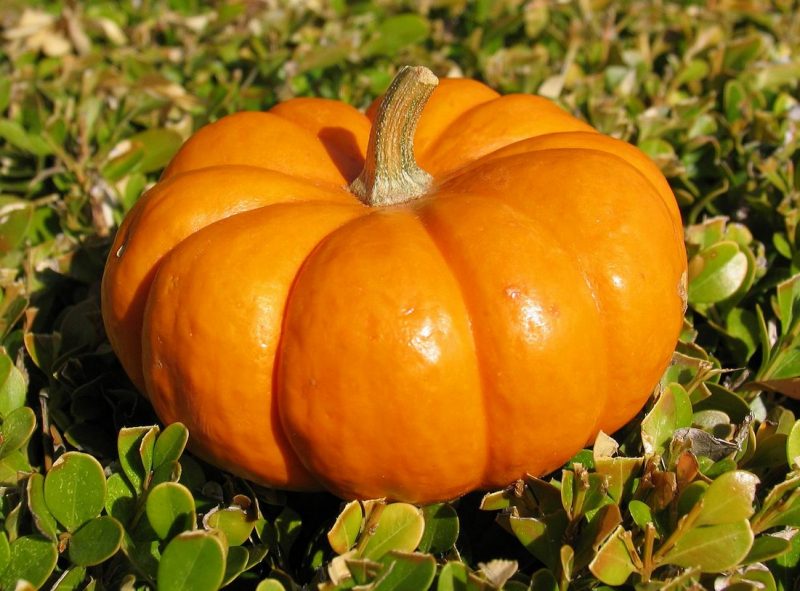
Hard-boiled pumpkins most often have a bush form, are convenient to grow. They contain a large amount of sugars.
- Smile - an early ripening variety, ripens already 3 months after germination. There are a lot of orange fruits on the bush - up to 15, but their weight is small - up to 1.5 kg. To get larger fruits, their number must be normalized. The smile has a sweet flesh, can be stored up to 5 months.
- Freckle - early ripening bush pumpkin variety. It forms 4 short whips with strongly dissected leaves, covered with white spots. Roundedly flattened fruits are medium-sized, up to 3 kg in weight. They have a light green color with a yellowish mesh pattern. The pulp is orange with a pear flavor, sweet. It is stored for a very long time.
- Bush orange - an early ripe grade with fruits up to 5 kg of orange color. The taste of the vegetable is excellent, the pumpkin is well stored, unpretentious in cultivation.
Large-fruited pumpkins are intended for lovers of large fruits.They are considered the sweetest, easily adapt to adverse conditions.
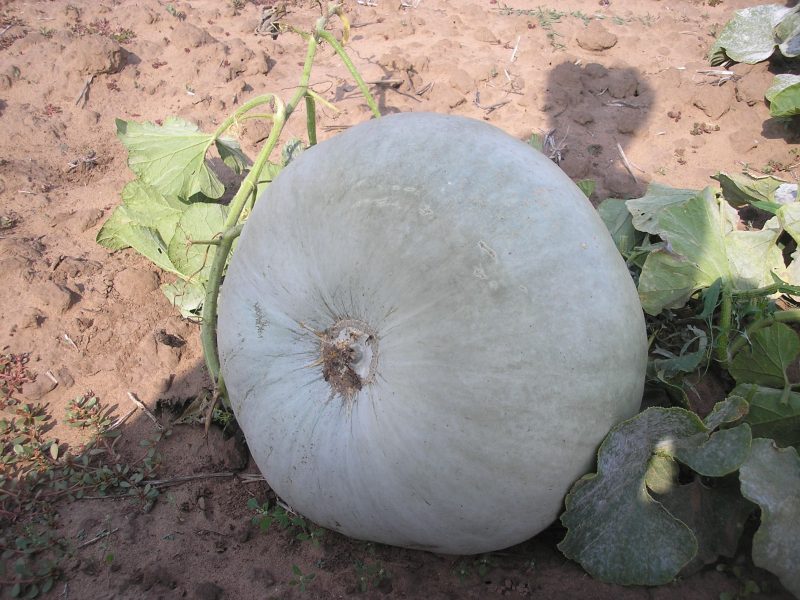
- Volga gray - ripen 4 months after germination. Gives powerful whips and fruits with an average weight of up to 7 kg of gray. Taste good with moderate sweetness, very well stored.
- Dawn - Matures early in the medium. Its fruits weighing about 5 kg have a segmented surface and a beautiful dark gray color with bright pinkish-orange spots. The bright orange pulp contains a lot of sugars and tastes good, and the carotene in it is just a record amount - more than in carrots. This variety has high resistance to many diseases of pumpkin crops.
- Medical - an early ripe variety, has a slightly segmented rounded shape. The fruits reach a weight of 5 kg, have a gray color with a lighter mesh, stored until the end of spring.
Nutmeg pumpkin is more thermophilic than its other relatives, it requires more time for its cultivation. Many nutmeg pumpkins are elongated. Their seeds are concentrated in the widest part of the fruit, so there is more tasty pulp compared to other varieties. All pumpkins of this group are well stored.

- Butternut. Belongs to late ripening varieties. Small portioned fruits have a weight of up to 1.5 kg, pear-shaped and light gray in color.
- Vitamin - late ripening grade. It has an elongated shape and green color with barely visible stripes. Fruit weight up to 6.5 kg.
- Prikubanskaya - mid-season. The weight of one pumpkin is up to 5 kg. It has a pear-shaped and light beige color.
Features of growing pumpkins
Pumpkin is a thermophilic vegetable. To form a large crop, she needs fertile soil, enough moisture and proper plant formation. A long core root allows the plant to extract nutrition and moisture from the lower layers of the soil. Powerful leaf mass and large fruits require a high nutritional density, therefore, for bush varieties, the minimum distance between plants is 0.5 m, and for climbing plants - at least 1 m.
Outdoor landing
To grow in comfort, a pumpkin needs a soil temperature at a depth of 10 cm of at least 10 degrees. Pumpkin loves warm air - at least 20 degrees.
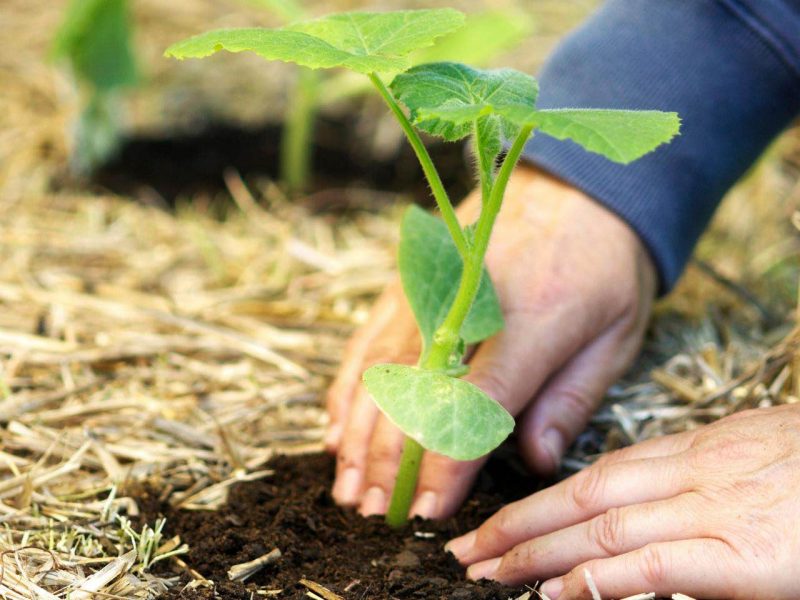
It is impossible to sow and plant it early. Therefore, the question arises, how best to grow it: seeds or seedlings?
Seeds or seedlings?
The choice depends on the maturity of the variety and the region in which the vegetable is going to be grown. In the south, seedlings are needed only for those who like to eat pumpkin in the middle of summer. In the middle lane and to the north, the choice is not so clear. Planting pumpkin seeds will yield fully ripe fruits if their growing season is early. But the cold summer can make its own adjustments - the lack of heat will not allow these varieties to give a full crop. Therefore, it is even better to grow them through seedlings, and even planting mid-ripening and late-ripening varieties can not do without it.
How and when to plant?
For growing seedlings, the best time is the end of April, the beginning of May, if you sow prepared and previously germinated seeds. After the return frosts and the establishment of warm weather, which happens in early June, it will be possible to plant ready seedlings at the age of about 30 days. It is not recommended to grow it longer - it will not have enough pot volume for full development.
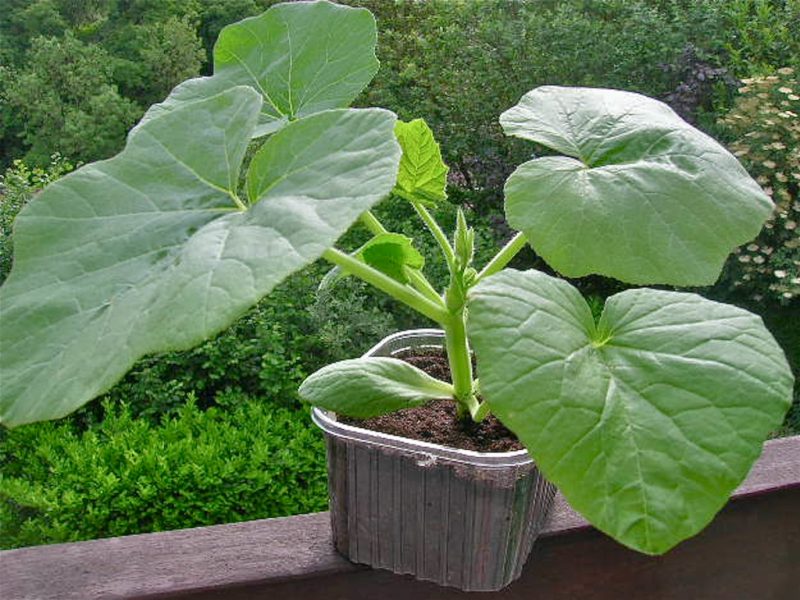
Seed preparation:
- calibration - selection of full, well-made seeds of the correct form, without damage;
- soaking in water with a temperature of about 50 degrees for 2 hours;
- germination in wet tissue in a warm place;
- hardening for 3-5 days by holding it in the refrigerator for ½ days and in a warm place with a temperature of about 20 degrees the rest of the time.
Prepared seeds are sown in peat pots or other dishes whose diameter and height should not be less than 10 cm.
Pumpkin negatively affects damage to the root system during transplantation.It is grown without picking, in individual containers, from where the sprouts are easy to extract without damaging the earthen lump.
The soil for cultivation should be loose, nutritious and breathable.
Seedling conditions:
- good lighting;
- about 22 degrees during the day and 5 degrees lower at night;
- watering with warm water as necessary, but without flooding the plants;
- 2 top dressing with full mineral fertilizer;
- hardening before planting for 3-5 days to accustom it to the conditions of open ground.
Seedlings are planted in prepared wells with the addition of humus near a bucket, a glass of ash and a pinch of mineral fertilizer. Watered with warm water in an amount of about 2 liters.
Sowing pumpkin seeds is carried out only in warm soil, otherwise the shoots can not wait.
Sowing technology:
- prepared beds are marked in accordance with the selected distance for each particular variety;
- dig holes, the depth of which depends on the mechanical composition of the soil: on the lungs - up to 10 cm, heavy - not deeper than 5;
- 2 handfuls of humus are poured into each hole, and on poor soils even to the bucket, but then the hole should be deeper, add ash and mineral fertilizers, water and spread 2-3 sprouted seeds;
- sprinkle seeds with soil, slightly compact, close the bed with a film so that the seeds germinate faster;
- when shoots appear, the film can be removed or left on the bed, making cross-shaped incisions for the shoots in it;
- the extra shoots are cut, but not pulled out.
Ground requirement, location selection
According to the requirements of pumpkin for soil fertility, only cucumbers can be compared with it. It grows well on a compost heap, in the soil where manure was previously stored. If there is no such place, choose a bed in a sunny place on which for 3 years plants from the pumpkin family have not grown. Stagnant water for pumpkins is undesirable. The soil is prepared in the fall. The bed is well fertilized: for each square. m make up to 8 kg of manure, or compost, 15 g of potassium sulfate and 20 g of superphosphate. Nitrogen fertilizers in the amount of 15 g per 1 square. m contribute with spring loosening.
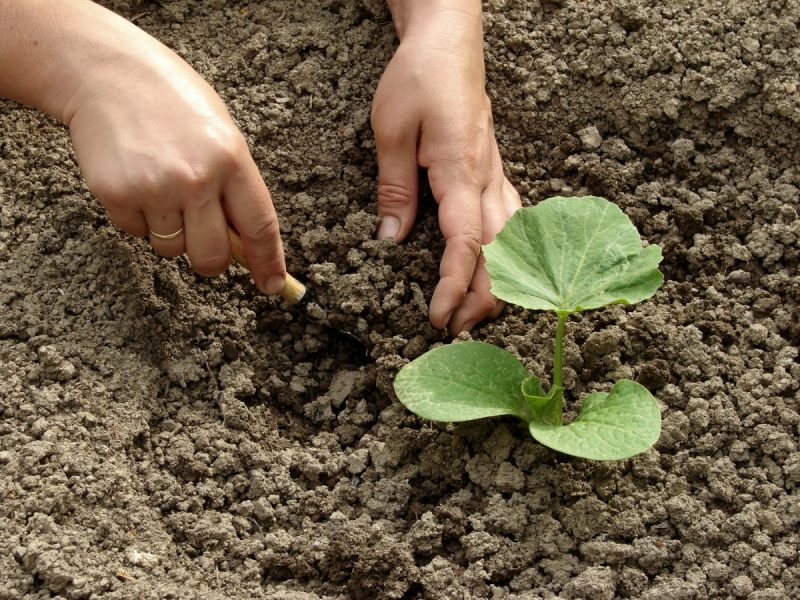
You can not overfeed the pumpkin with nitrogen, this will lead to an increase in leaf mass to the detriment of fruit formation.
You can plant pumpkins in pre-dug trenches filled with shredded branches, grass, manure, which are sprinkled with a layer of soil. The depth of the trench is 50 cm, and the width is up to 40 cm.
Pumpkin: Outdoor Care
Successful pumpkin cultivation is impossible without observing all the rules of agricultural technology: watering, cultivating, fertilizing.
Watering and feeding
Young plants are most sensitive to lack of moisture. They are watered regularly at intervals of 4-5 days. After the root system has grown, irrigation is less common, but at least 1.5 buckets of water are poured onto the plant to wet the entire root layer. Excessive moisture can provoke too strong leaf growth to the detriment of the crop, cracking of the fruit, rotting of the roots. During the ripening period of pumpkins, a large amount of moisture will lead to a decrease in sugar content. Therefore, a vegetable is better to be shortened than transfused.

Pumpkins are fed 2 times with a solution of a complete mineral fertilizer:
- in the phase of 3-4 leaves;
- during the growth of lashes.
Pumpkin also responds well to organic dressings, which can be applied once every 2 weeks. With the growth of pumpkins, fertilizer doses per plant increase.
Loosening and thinning
Getting enough air to the roots is a prerequisite for successful pumpkin development. Therefore, the soil under it is loosened after each watering, hilling plants in the phase of 3-4 real leaves and sprinkling the internodes of the overgrown lashes with earth to form additional roots.

Thinning plants in the seedling phase, leaving in the hole only one of the strongest sprout.
Pumpkin lash formation
So that the fruits are larger and have time to fully ripen, do not leave all the ovaries on the plant, and pinch the whips.In long-climbing varieties, all axillary shoots are removed without pinching the main lash. 1 fruit is left on it, and if they want their size to be portioned, then several. In bush varieties, pinch the stem 4 leaves after the formation of the fruit. All shoots on which there are no fruits are also removed.
Pumpkin Diseases and Pests
Pumpkin is affected by diseases caused by fungus-like microorganisms: powdery mildew, root and white rot, bacteriosis. All of them are treated with copper-containing fungicides: Bordeaux liquid and copper chloroxide. Processing is carried out in accordance with the instructions.
Soaking seeds for a day in a solution of zinc sulfate of 0.02% concentration will be a good preventive measure.
The most common pests are spider mites and gourds. If the plant already has ovaries, chemical treatment is undesirable. Apply folk methods. They can not always completely destroy the pest, but will reduce its number many times over. For spraying against the spider mite, a solution of 200 g of onion husks and 10 l of boiling water is prepared. After insisting for 2 days and filtering, the infusion is ready for use. It will help against aphids.
Harvesting and storage
Unripe pumpkin is poorly stored. Therefore, for long-term storage, only those fruits are collected that have acquired a color corresponding to the variety, their peel should harden. This should be done before the onset of frost in dry and preferably sunny weather. Harvested carefully, avoiding mechanical damage, from which the fruits quickly rot. Not fully ripe pumpkins are used immediately after harvest, or processed. The fruit must leave part of the stalk not less than 5 cm long.

The first two weeks of pumpkins finally ripen. For this, a temperature of at least 14 degrees is needed. In the future, from 3 to 8 degrees will be enough for storage, air humidity is maintained at a level of 70% or slightly lower. In such conditions, pumpkins do not dry out and are well stored for a long time.












